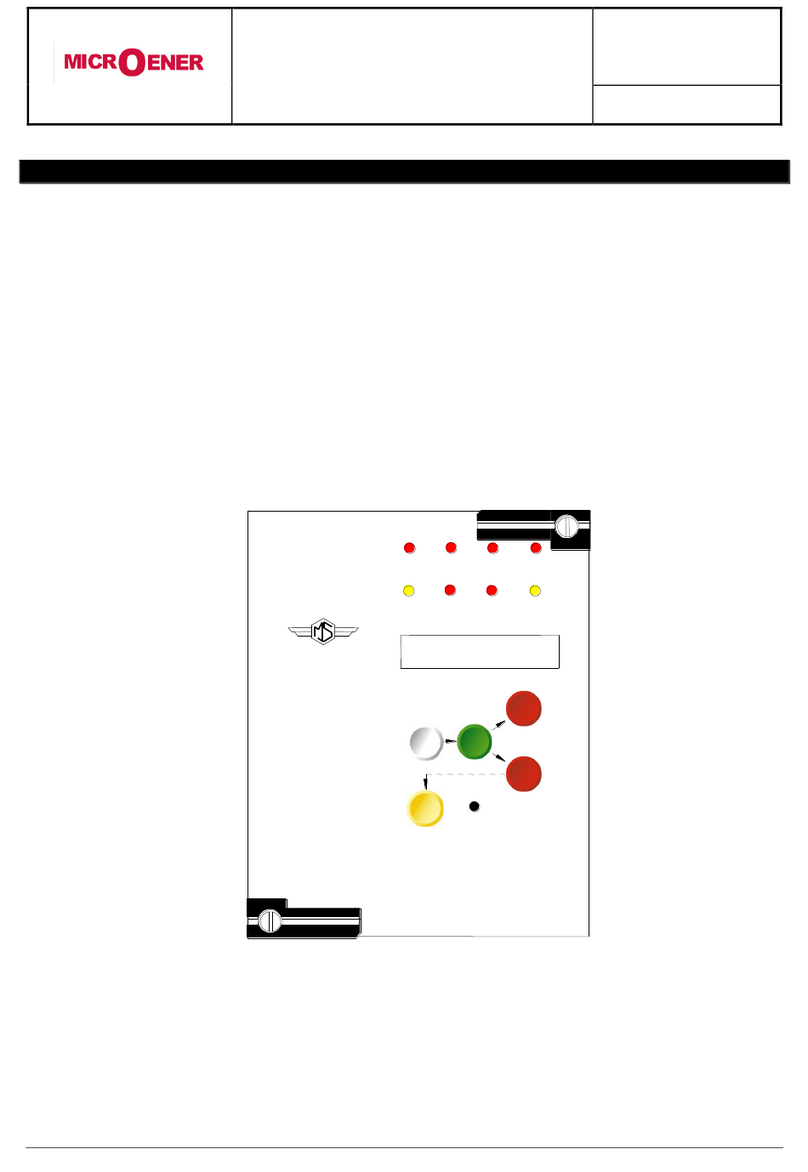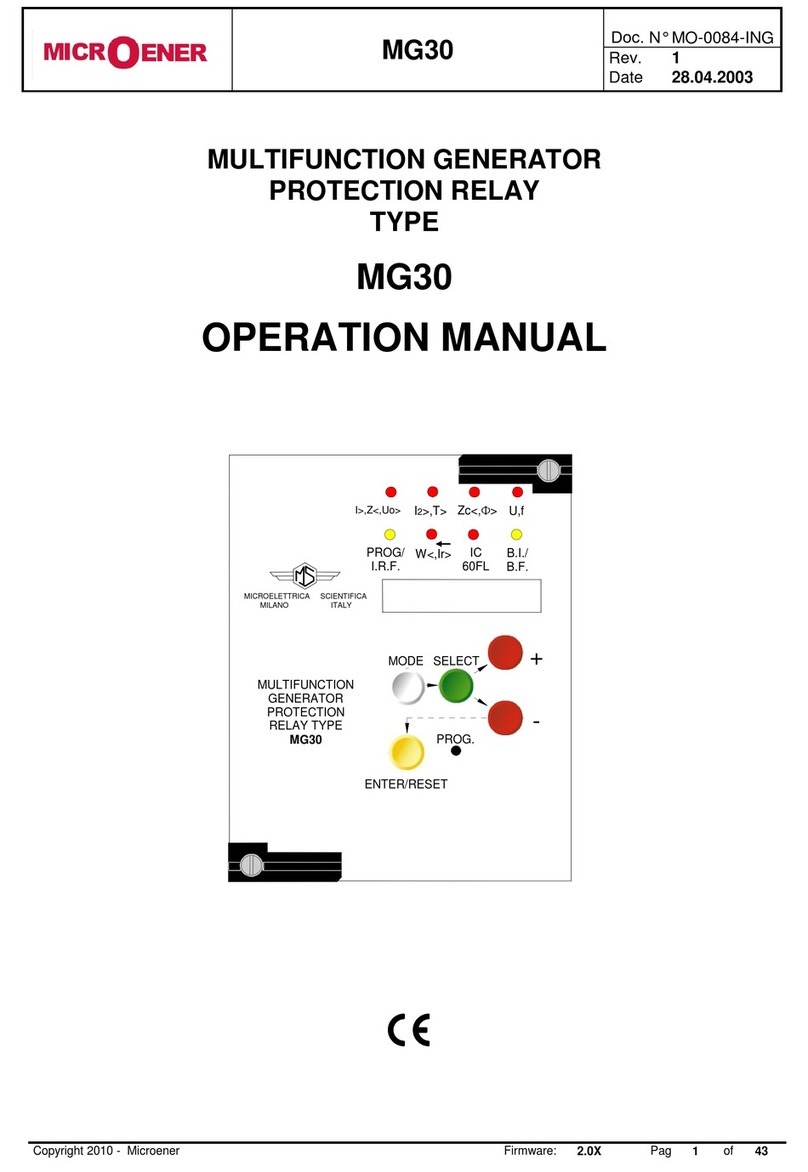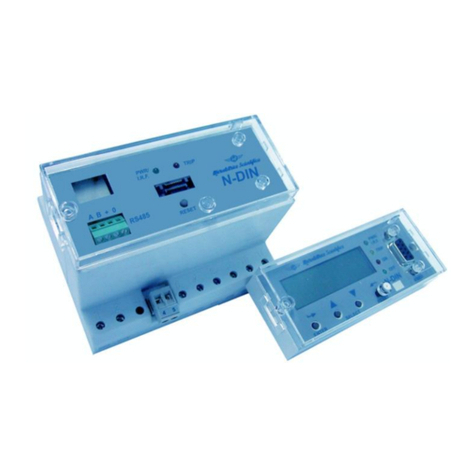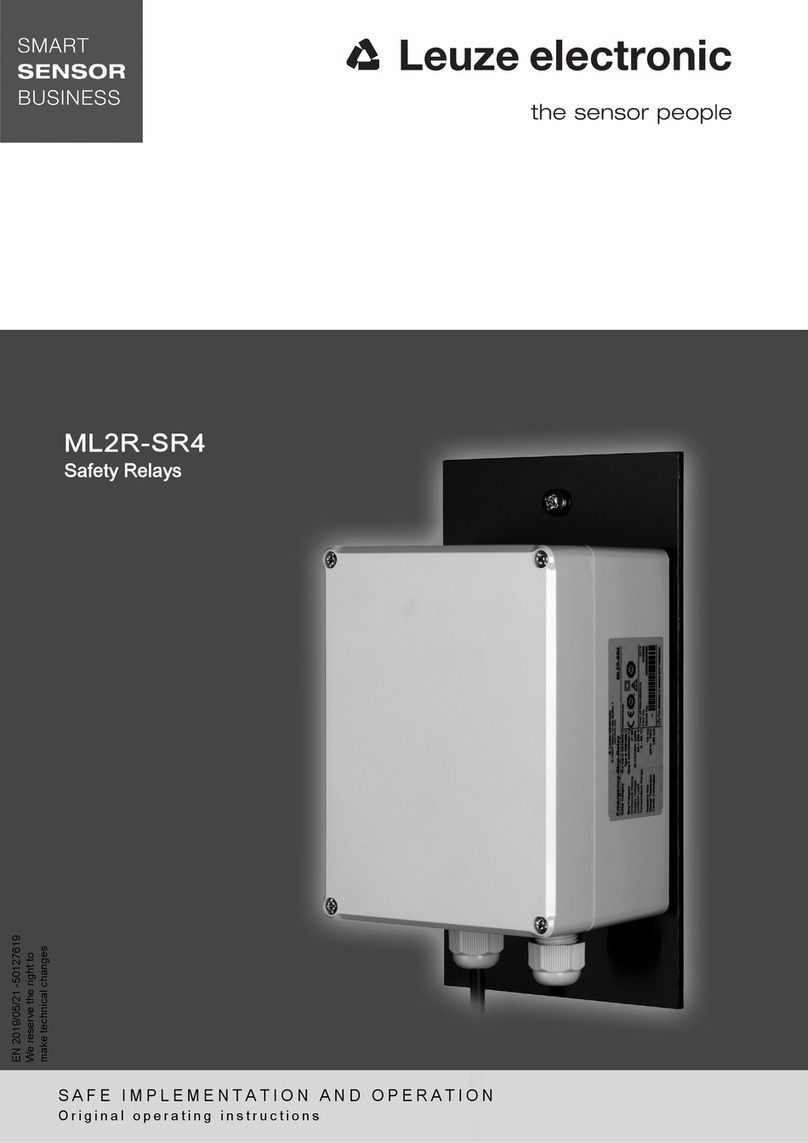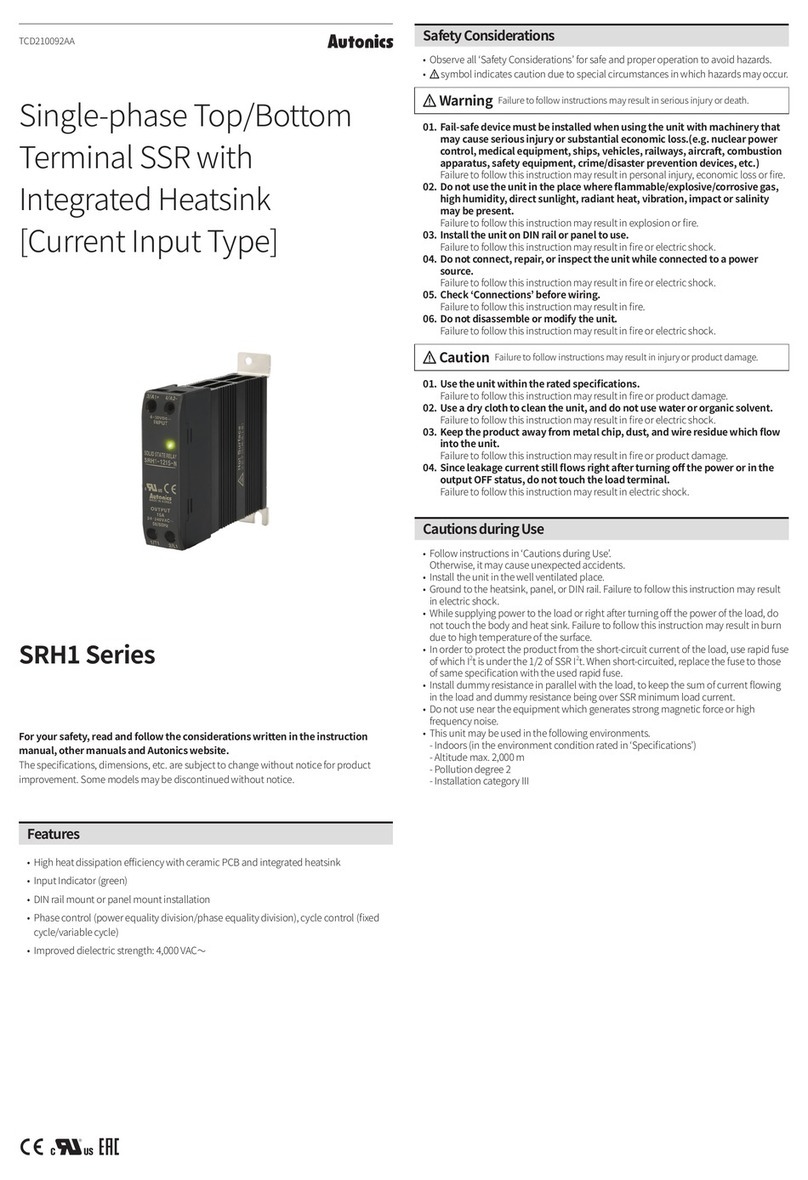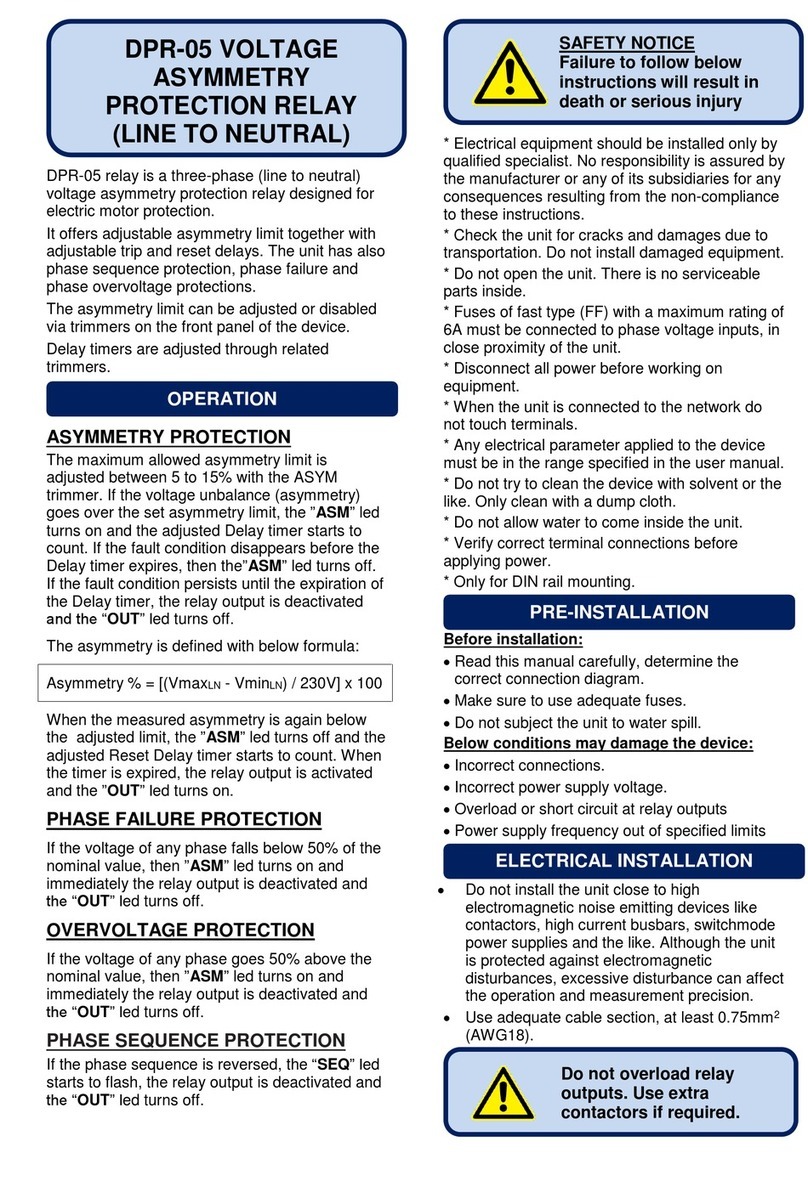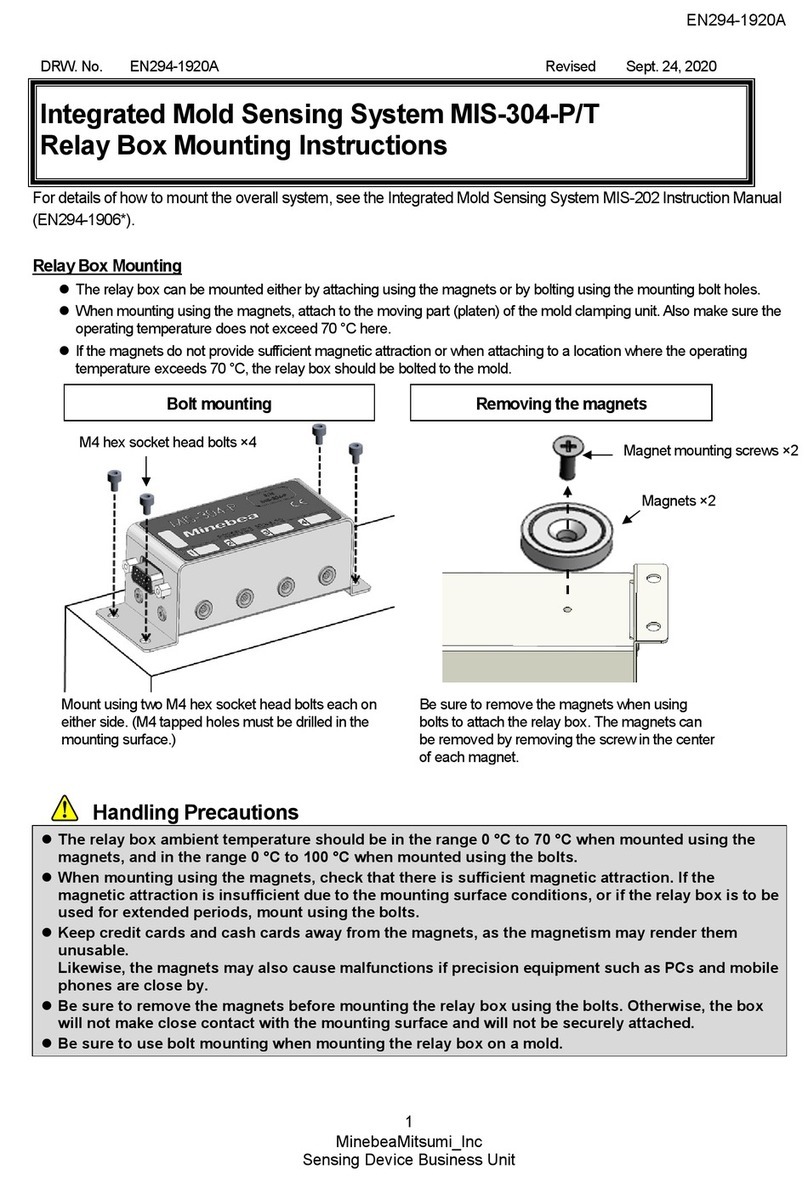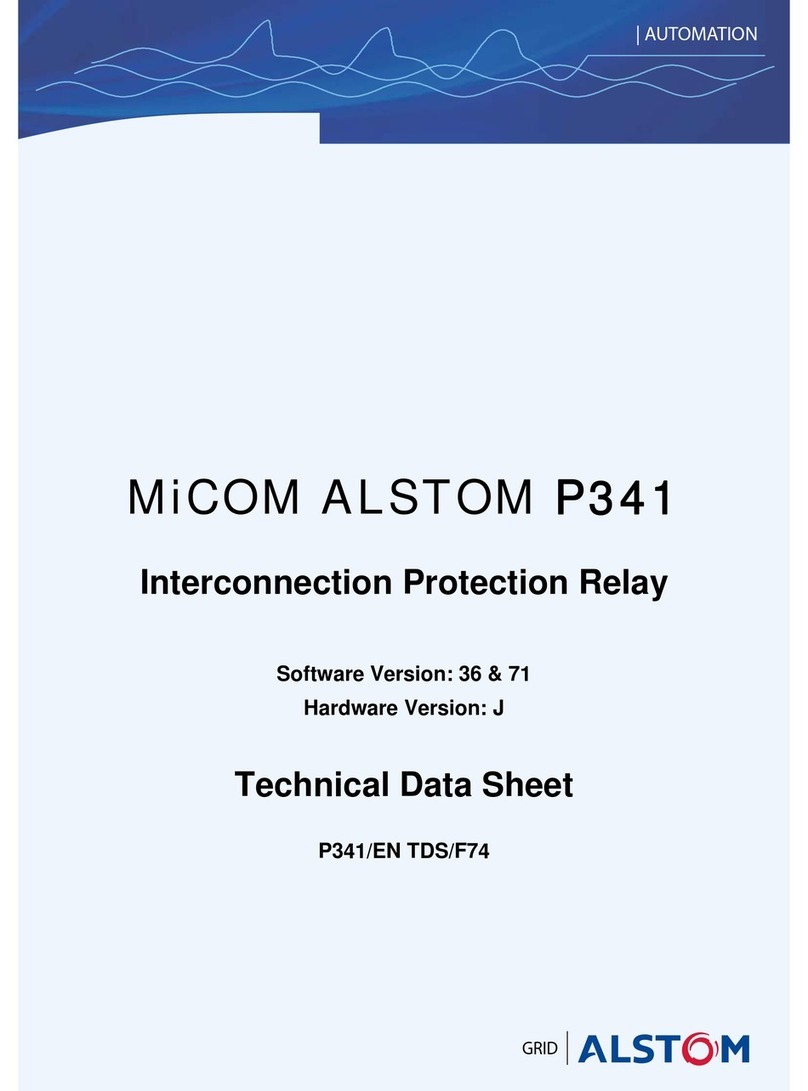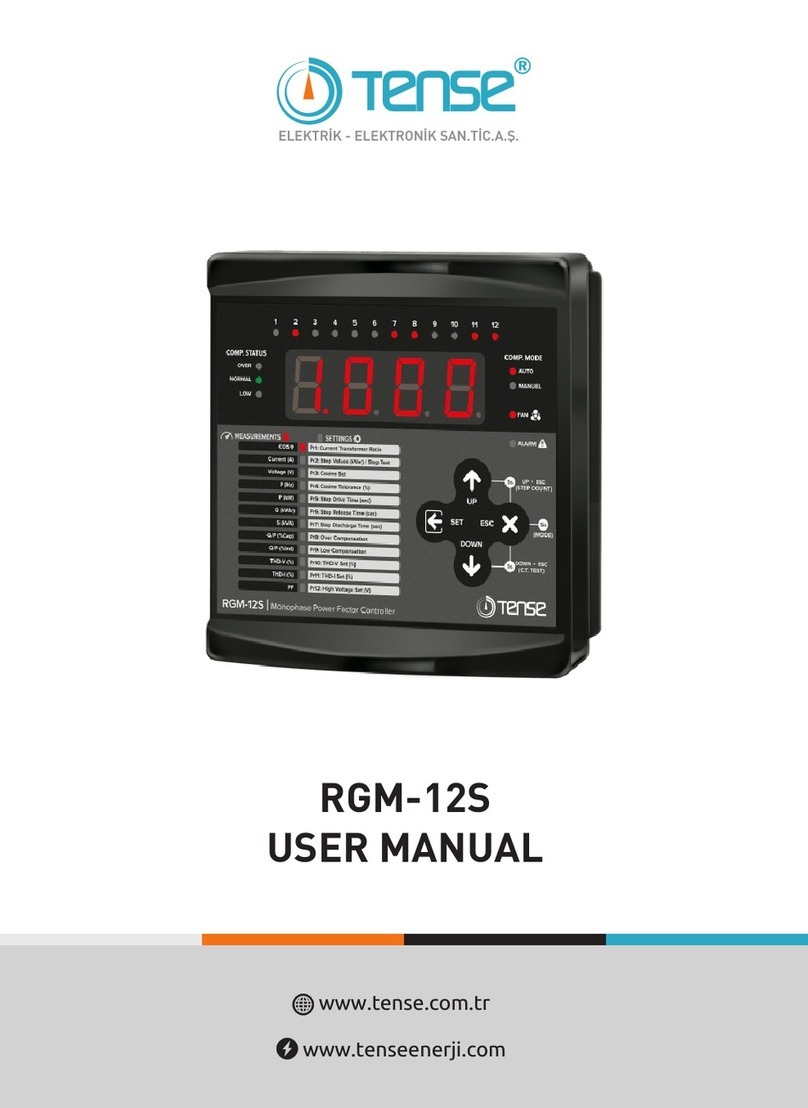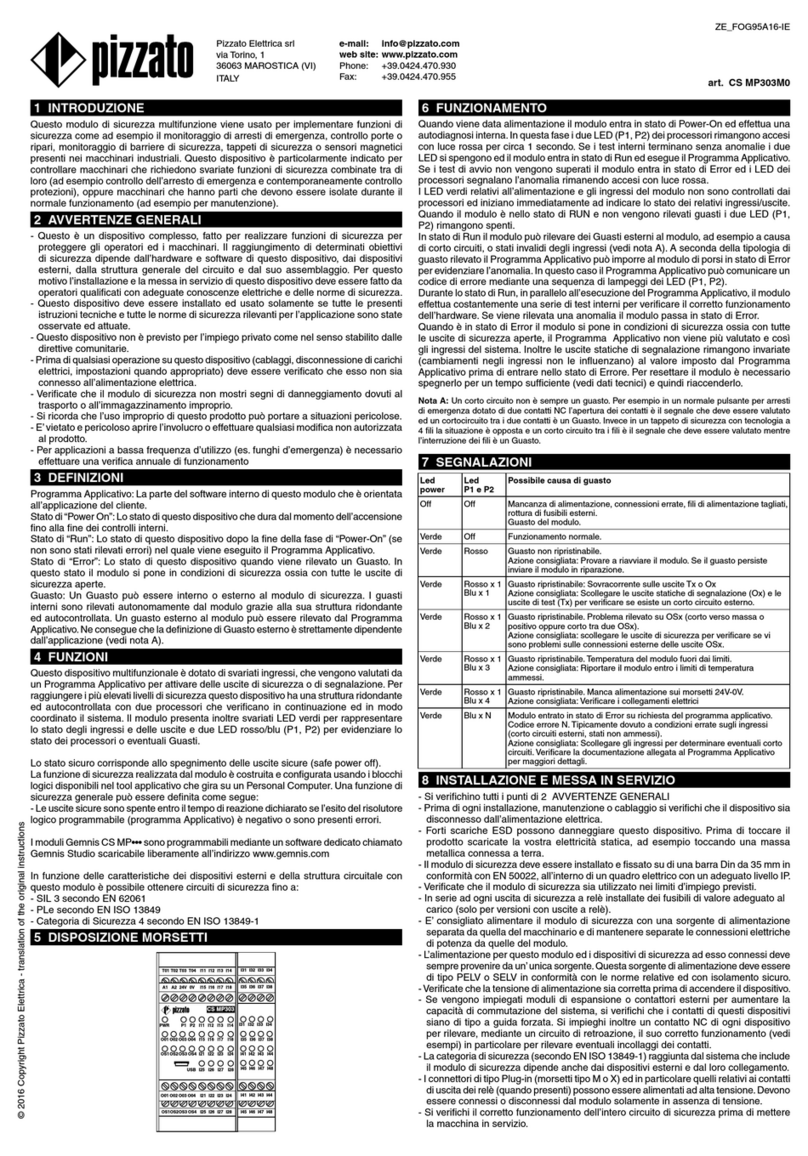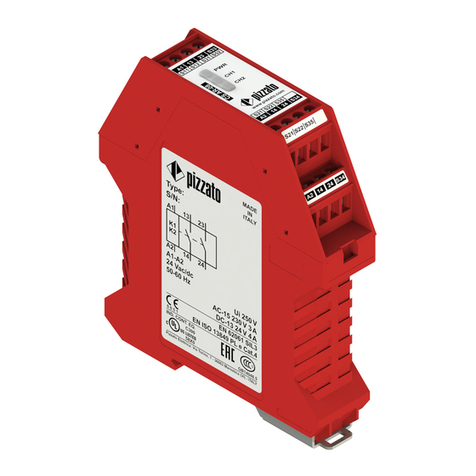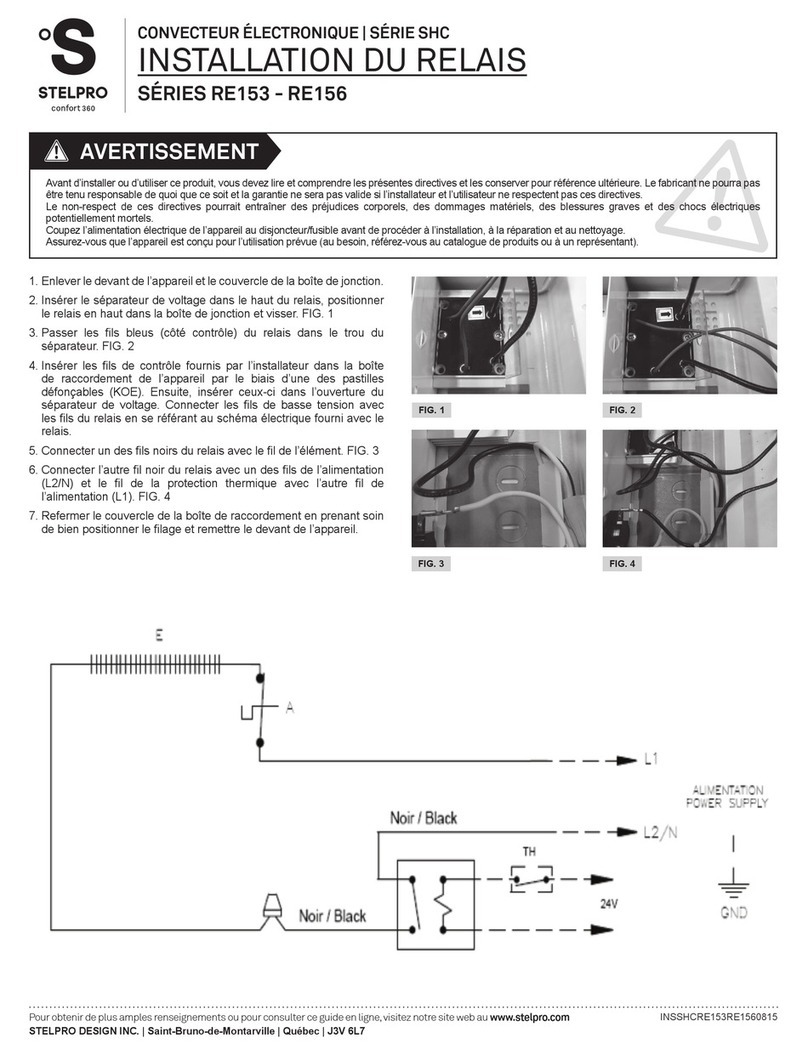MICROENER IM30-B00 User manual

IM30-B00
Doc. N° MO-0132-ING
Copyright 2010 - Microener
Firmware
2.0X
Data
22.04.2008
Rev.
2
Pag
1
of
23
MICROPROCESSOR
EARTH FAULT PROTECTION RELAY
TYPE
IM30-B00
OPERATION MANUAL

IM30-B00
Doc. N° MO-0132-ING
Copyright 2010 - Microener
Firmware
2.0X
Data
22.04.2008
Rev.
2
Pag
2
of
23
1. General utilization and commissioning directions_______________________________________________________ 3
1.1 - Storage and Transportation _______________________________________________________________________ 3
1.2 - Installation ____________________________________________________________________________________ 3
1.3 - Electrical Connection ____________________________________________________________________________ 3
1.4 - Measuring Inputs and Power Supply ________________________________________________________________ 3
1.5 - Outputs Loading________________________________________________________________________________ 3
1.6 - Protection Earthing _____________________________________________________________________________ 3
1.7 - Setting and Calibration___________________________________________________________________________ 3
1.8 - Safety Protection _______________________________________________________________________________ 3
1.9 - Handling______________________________________________________________________________________ 3
1.10 - Maintenance__________________________________________________________________________________ 4
1.11 - Waste Disposal of Electrical & Electronic Equipment __________________________________________________ 4
1.12 - Fault Detection and Repair ______________________________________________________________________ 4
2. General __________________________________________________________________________________________ 4
2.1 - Power Supply__________________________________________________________________________________ 4
2.2 - Algorithm of the time current curves ________________________________________________________________ 5
2.3 - Clock and Calendar _____________________________________________________________________________ 6
2.3.1 - Clock synchronization. _______________________________________________________________________ 6
2.3.2 - Date and time setting.________________________________________________________________________ 6
2.3.3 - Time resolution. ____________________________________________________________________________ 6
2.3.4 - Operation during power off. ___________________________________________________________________ 6
2.3.5 - Time tolerance._____________________________________________________________________________ 6
3. Controls and Measurements _________________________________________________________________________ 7
4. Signalizations _____________________________________________________________________________________ 8
5. Output Relays _____________________________________________________________________________________ 9
6. Serial Communication ______________________________________________________________________________ 9
7. Digital Inputs_____________________________________________________________________________________ 10
8. Test ____________________________________________________________________________________________ 10
9. Keyboard and Display Operation ____________________________________________________________________ 11
10. Reading of Measurements and Recorded Parameters __________________________________________________ 12
10.1 - ACT.MEAS__________________________________________________________________________________ 12
10.2 - LASTTRIP __________________________________________________________________________________ 12
10.3 - TRIP NUM __________________________________________________________________________________ 12
11. Reading of Programmed Settings and Relay's Configuration ____________________________________________ 12
12. Programming ___________________________________________________________________________________ 13
12.1 - Programming of functions settings________________________________________________________________ 13
12.2 - Programming the configuration of output relays _____________________________________________________ 14
13. Manual Test Operation____________________________________________________________________________ 15
13.1 - Mode "TESTPROG" subprogram "W/O TRIP"_______________________________________________________ 15
13.2 - Mode "TESTPROG" subprogram "WithTRIP" _______________________________________________________ 15
14. Maintenance ____________________________________________________________________________________ 15
15. Power Frequency Insulation Test ___________________________________________________________________ 15
16. Electrical Characteristics__________________________________________________________________________ 16
17. Connection Diagram______________________________________________________________________________ 17
18. Wiring the Serial Communication Bus _______________________________________________________________ 17
19. Time Current Curves IEC (TU0388 Rev.0 1/2)__________________________________________________________ 18
20. Time Current Curves IEEE (TU0388 Rev.0 2/2) ________________________________________________________ 19
21. Direction for Pcb's Draw-Out and Plug-In ____________________________________________________________ 20
21.1 - Draw-out____________________________________________________________________________________ 20
21.2 - Plug-in _____________________________________________________________________________________ 20
22. Mounting _______________________________________________________________________________________ 21
23. Keyboard Operational Diagram_____________________________________________________________________ 22
24. Setting’s Form___________________________________________________________________________________ 23

IM30-B00
Doc. N° MO-0132-ING
Copyright 2010 - Microener
Firmware
2.0X
Data
22.04.2008
Rev.
2
Pag
3
of
23
1. General utilization and commissioning directions
Always make reference to the specific description of the product and to the Manufacturer's instruction.
Carefully observe the following warnings.
1.1 - Storage and Transportation
must comply with the environmental conditions stated on the product's instruction or by the applicable
IEC standards.
1.2 - Installation
must be properly made and in compliance with the operational ambient conditions stated by the
Manufacturer.
1.3 - Electrical Connection
must be made strictly according to the wiring diagram supplied with the Product, to its electrical
characteristics and in compliance with the applicable standards particularly with reference to human
safety.
1.4 - Measuring Inputs and Power Supply
carefully check that the value of input quantities and power supply voltage are proper and within the
permissible variation limits.
1.5 - Outputs Loading
must be compatible with their declared performance.
1.6 - Protection Earthing
When earthing is required, carefully check its effectiveness.
1.7 - Setting and Calibration
Carefully check the proper setting of the different functions according to the configuration of the
protected system, the safety regulations and the co-ordination with other equipment.
1.8 - Safety Protection
Carefully check that all safety means are correctly mounted, apply proper seals where required and
periodically check their integrity.
1.9 - Handling
Notwithstanding the highest practicable protection means used in designing M.S. electronic circuits,
the electronic components and semiconductor devices mounted on the modules can be seriously
damaged by electrostatic voltage discharge which can be experienced when handling the modules.
The damage caused by electrostatic discharge may not be immediately apparent but the design
reliability and the long life of the product will have been reduced. The electronic circuits reduced by
M.S. are completely safe from electrostatic discharge (8 KV IEC 255.22.2) when housed in their case;
withdrawing the modules without proper cautions expose them to the risk of damage.

IM30-B00
Doc. N° MO-0132-ING
Copyright 2010 - Microener
Firmware
2.0X
Data
22.04.2008
Rev.
2
Pag
4
of
23
a.
Before removing a module, ensure that you are at the same electrostatic potential as the equipment
by touching the case.
b.
Handle the module by its front-plate, frame, or edges of the printed circuit board. Avoid touching the
electronic components, printed circuit tracks or connectors.
c.
Do not pass the module to any person without first ensuring that you are both at the same
electrostatic potential. Shaking hands achieves equipotential.
d.
Place the module on an antistatic surface, or on a conducting surface which is at the same potential
as yourself.
e.
Store or transport the module in a conductive bag.
More information on safe working procedures for all electronic equipment can be found in
BS5783 and IEC 147-OF.
1.10 - Maintenance
Make reference to the instruction manual of the Manufacturer; maintenance must be carried-
out by specially trained people and in strict conformity with the safety regulations.
1.11 - Waste Disposal of Electrical & Electronic Equipment
(Applicable throughout the European Union and other European countries with separate collection
program).
This product should not be treated as household waste when you wish dispose of it. Instead, it should
be handed over to an applicable collection point for the recycling of electrical and electronic equipment.
By ensuring this product is disposed of correctly, you will help prevent potential negative consequence to
the environment and human health, which could otherwise be caused by inappropriate disposal of this
product. The recycling of materials will help to conserve natural resource.
1.12 - Fault Detection and Repair
Internal calibrations and components should not be altered or replaced.
For repair please ask the Manufacturer or its authorised Dealers.
Misapplication of the above warnings and instruction relieves the Manufacturer of any liability.
2. General
Input currents are supplied to 2 current transformers measuring the earth fault zero-sequence current.
The first (HI = High Input) supplied from terminals 29 –28 (5A) or 29 –30 (1A) operates the third
high-set Earth Fault element 3I.
The second (LI = Low Input) supplied from terminals 32 –31 (5A) or 32 –33 (1A) operates the first and
the second Low-set Earth Fault elements 1I, 2I.
Taps for 1A and 5A input are provided on relay’s terminal board.
Make electric connection in conformity with the diagram reported on relay's enclosure.
Check that input currents are same as reported on the diagram and on the test certificate.
2.1 - Power Supply
The relay can be fitted with two different types of power supply module :
24V(-20%) / 110V(+15%) a.c.
80V(-20%) / 220V(+15%) a.c.
a)
-
b)
-
24V(-20%) / 125V(+20%) d.c.
90V(-20%) / 250V(+20%) d.c.
Before energising the unit check that supply voltage is within the allowed limits.

IM30-B00
Doc. N° MO-0132-ING
Copyright 2010 - Microener
Firmware
2.0X
Data
22.04.2008
Rev.
2
Pag
5
of
23
rs
atTKB
1
Is
I
A
t(I)
2.2 - Algorithm of the time current curves
The Time Current Curves are generally calculated with the following equation :
(1) where :
t(I) = Actual trip time delay when the input current equals I
Is = Set minimum pick-up level
K =
Ts= Set time delay : t(I) = Tswhen
tr = Operation time of the output relay on pick-up.
The parameters A, B and a have different values for the different Time Current Curves.
Curve Name
Curve Identifier
A
B
a
IEC A Inverse
A
0.14
0
0.02
IEC B Very Inverse
B
13.5
0
1
IEC C Extremely Inverse
C
80
0
2
IEEE Moderate Inverse
MI
0.0104
0.0226
0.02
IEEE Short Inverse
SI
0.00342
0.00262
0.02
IEEE Very Inverse
VI
3.88
0.0963
2
IEEE Inverse
I
5.95
0.18
2
IEEE Extremely Inverse
EI
5.67
0.0352
2
For the IEC curves, being B = 0, the Time/Current equation (1), becomes:
Where Kt = (10a-1)Ts is the time multiplier
1
aB
110A
10
II
s
tr
1
Is
IKt
tr
1
Is
ITs1-10
1' aa
a

IM30-B00
Doc. N° MO-0132-ING
Copyright 2010 - Microener
Firmware
2.0X
Data
22.04.2008
Rev.
2
Pag
6
of
23
2.3 - Clock and Calendar
The unit features a built in clock calendar with Years, Months, Days, Hours, Minutes, Seconds, Tenths
of seconds and Hundredths of seconds.
2.3.1 - Clock synchronization.
The clock can be synchronized via the serial communication interface.
The following synchronization periods can be set: 5, 10, 15, 30, 60 minutes.
Synchronization can also be disabled, in which case the relay ignores the serial broadcast signal.
In case synchronization is enabled, the unit expects to receive a sync signal at the beginning of every
hour and once every Tsyn minutes. When a sync signal is received, the clock is automatically set to
the nearest expected synchronization time.
For example: if Tsyn is 10min and a sync signal is received at 20:03:10 January the 10th, 98, then the
clock is set to 20:00:00 January the 10th, 1998.
On the other hand, if the same sync signal were received at 20:06:34, the clock would be set to
20:10:00, January the 10th 98.
Note that if a sync signal is received exactly in the middle of a Tsyn period, the clock is set to the
previous expected synchronization time.
2.3.2 - Date and time setting.
When the PROG/SETTINGS menu is entered, the current date is displayed with one of the groups of
digits (YY, MMM or DD) blinking.
The DOWN key operates as a cursor. It moves through the groups of digits in the sequence YY =>
MMM => DD => YY => …
The UP key allows the user to modify the currently blinking group of digits.
If the ENTER button is pressed the currently displayed date is set.
Pressing the SELECT button the current time is displayed which can be modified using the same
procedure as for the date.
If synchronization is enabled and the date (or time) is modified, the clock is stopped until a sync
signal is received via the serial port. This allows the user to manually set many units and have them
to start their clocks in a synchronized fashion.
If synchronization is disabled the clock is never stopped.
Note that the setting of a new time always clears 10ths and 100ths of sec.
2.3.3 - Time resolution.
The clock has a 10ms resolution. This means that any event can be time-stamped with a 10ms
accuracy, although the information concerning 10ths and 100ths of sec. can be accessed only via
the serial communication interface.
2.3.4 - Operation during power off.
The unit has an on board Real Time Clock which maintains time information for at least 1 hour in
case of power supply failure.
2.3.5 - Time tolerance.
During power on, time tolerance depends on the on board crystal (+/-50ppm typ, +/-100ppm max.
over full temperature range).
During power off, time tolerance depends on the RTC’s oscillator (+65 /–270 ppm max over full
temperature range).

IM30-B00
Doc. N° MO-0132-ING
Copyright 2010 - Microener
Firmware
2.0X
Data
22.04.2008
Rev.
2
Pag
7
of
23
3. Controls and Measurements
Five key buttons allow for local management of all relay's functions.
A 8-digit high brightness alphanumerical display shows the relevant readings (xxxxxxxx)
(see synoptic table fig.1)
FIG.1

IM30-B00
Doc. N° MO-0132-ING
Copyright 2010 - Microener
Firmware
2.0X
Data
22.04.2008
Rev.
2
Pag
8
of
23
4. Signalizations
Eight signal leds (normally off) are provided:
a)
Red LED
Io>
Flashing when measured current exceeds the set trip level [1I].
Illuminated on trip after expiry of the set trip time delay [t1I].
b)
Red LED
Io>>
Same as above related to [2I], [t2I].
c)
Red LED
Io>>>
Same as above related to [3I], [t3I].
d)
Red LED
Ch Set
Off when setting program 1 is active.
Illuminated when setting program 2 is active.
e)
Yellow LED
PROGR/
I.R.F.
Flashing during the programming of the parameters or in case of
Internal Relay Fault.
f)
Red LED
BLOCK
INPUT
Flashing when a blocking signal is present at the relevant input
terminals.
g)
Red LED
BR.FAIL.
Lit-on when the BREAKER FAILURE function is activated.
h)
Yellow LED
FUNC.
DISAB.
Lit-on when the operation of one or more of the relay functions has
been disactivated in the programming.
The reset of the leds takes place as follows:
Leds
a,b,c,g
:
From flashing to off, automatically when the lit-on cause disappears.
From ON to OFF, by "ENTER/RESET" push button or via serial
communication only if the tripping cause has disappeared.
Leds
d,e,f,h
:
From ON to OFF, automatically when the lit-on cause disappears.
In case of auxiliary power supply failure the status of the leds is recorded and reproduced when power
supply is restored.

IM30-B00
Doc. N° MO-0132-ING
Copyright 2010 - Microener
Firmware
2.0X
Data
22.04.2008
Rev.
2
Pag
9
of
23
5. Output Relays
Five output relays are available (R1, R2, R3, R4, R5)
a) - The relays R1,R2,R3,R4 are normally deenergized (energised on trip); these output relays are user
programmable and any of them can be associated to any (one or more) of the IM30-AB's functions.
One relay eventually associated to the instantaneous element of one of the functions, after pick-up,
normally drops-out as soon as the tripping cause disappears (current below the set trip level).
If the current remains above the trip level longer than the time delay programmed for the time delayed
element of the some function, the drop-out of the instantaneous relay is anyhow forced after an
adjustable waiting time [tBF]. (Diasactivation of the blocking output eventually used to block a relay
upstream in the distribution system). The timer tBF is also started at any time the relay R1 picks-up and
any relays R2, R3, R4 can be programmed to be energized at the end of the delay tBF (Breaker Failure
functions).
Reset of the output relays associated to any time delayed function can be programmed to take place
“Automatically” (tFRes= A) as soon as the tripping cause has disappeared, or “Manually” (tFRes= M)
only by operating the ENTER/RESET key on relay’s front or via the serial bus.
It has to be remarked that the programming structure does not allow to associate the same relay at the
same time to instantaneous and delayed elements. Therefore any relay already associated to any time
delayed element cannot be associated to any instantaneous element and viceversa.
b) - The relay R5, normally energised, is not programmable and it is deenergized on:
internal fault
power supply failure
during the programming
6. Serial Communication
The relays fitted with the serial communication option can be connected via a cable bus a fiber optic bus
for interfacing with a Personal Computer (type IBM or compatible).
All the functionalities that can be operated locally (for example reading of input measurement and
changing of relay’s settings) are also possible via the serial communication interface.
Furthermore the serial port allows the user to read event recording and stored data.
The unit has a RS232 / RS485 interface and can be connected either directly to a P.C. via a dedicated
cable or to a RS485 serial bus, allowing having many relays to exchange data with a single master P.C.
using the same physical serial line. A RS485/232 converter is available on request.
The communication protocol is MODBUS RTU (only functions 3, 4 and 16 are implemented).
Each relay is identified by its programmable address code (NodeAd) and can be called from the P.C.
A dedicated communication software (MSCom) for Windows 95/98/NT4 SP3 (or later) is available.
Please refer to the MSCom instruction manual for more information Microelettrica Scientifica.

IM30-B00
Doc. N° MO-0132-ING
Copyright 2010 - Microener
Firmware
2.0X
Data
22.04.2008
Rev.
2
Pag
10
of
23
7. Digital Inputs
Three digital inputs are provided: they are active when the relevant terminals are shorted
B2
(terminals 1 - 2)
:
it blocks the operation of the time delayed elements t1I and t2I.
B3
(terminals 1 - 3)
:
it blocks the operation of the time delayed elements t3I.
B4
(terminals 1 - 14)
:
Switching-over from Setting Program 1 (SP1) to Setting Program 2 (SP2)
- Terminals 1 –14 Open = Setting Program 1 active
- Terminals 1 –14 Shorted = Setting Program 2 active
The input B4 can also be activated via the serial communication port.
In this case Switching-back from SP2 to SP1 can only be made via serial
port.
Viceversa if the terminals 1 –14 are shorted, switching-back from SP2 to
SP1 cannot be made via the serial port.
When a function is blocked the pick-up of its time delayed output is inhibited. Programming allows to
have the inhibition either permanent as long as the blocking input is active (tB2=Dis; tB3=Dis) or
automatically removed after the expiry of the set trip time delay of the function involved plus an
additional time 2tBF (tB2=2tBF; tB3=2tBF). By proper interconnection of the blocking inputs and outputs
of different relays it is possible to configurate very efficient arrangements of logic fault discrimination as
well as to feature a safe and quick breaker back-up protection.
8. Test
Besides the normal "WATCHDOG" and "POWERFAIL" functions, a comprehensive program of self-test
and self-diagnostic provides:
Diagnostic and functional test, with checking of program routines and memory's content, run every
time the aux. power is switched-on: the display shows the type of relay and its version number.
Dynamic functional test run during normal operation every 15 min. (relay's operation is suspended
for less than 4ms). If any internal fault is detected, the display shows a fault message, the Led
"PROG/IRF" illuminates and the relay R5 is deenergized.
Complete test activated by the keyboard or via the communication bus either with or without tripping
of the output relays.

IM30-B00
Doc. N° MO-0132-ING
Copyright 2010 - Microener
Firmware
2.0X
Data
22.04.2008
Rev.
2
Pag
11
of
23
9. Keyboard and Display Operation
All controls can be operated from relay's front.
The keyboard includes five hand operable buttons (MODE) - (SELECT) - (+) - (-) - (ENTER/RESET)
plus one indirect operable key (PROG) (see synoptic table a fig.1):
a)
-
MODE
:
When operated it enters one of the following operation modes
indicated on the display :
MEASURES
=
Reading of all the parameters measured and of those recorded
in the memory
SET DISP
=
Reading of the settings and of the configuration of the output
relays as programmed.
PROG
=
Access to the programming of the settings and of relay
configuration.
TEST PROG
=
Access to the manual test routines.
b)
-
SELECT
:
When operated it selects one of the menus available in the
actual operation MODE
When in the program mode scroll the parameters.
c)
-
“+”AND “-“
:
The + and - buttons are used to select the actual measurement
or display desired when in Measurements Display or Settings
Display modes. When in Program mode, these buttons increase
or decrease the value of the displayed setting.
d)
-
ENTER/RESET
:
It allows the validation of the programmed settings
- the actuation of test programs
- the forcing of the default display indication
- the reset of signal Leds.
e)
-
PROG.
:
Enables access to the programming.

IM30-B00
Doc. N° MO-0132-ING
Copyright 2010 - Microener
Firmware
2.0X
Data
22.04.2008
Rev.
2
Pag
12
of
23
10. Reading of Measurements and Recorded Parameters
Enter the MODE "MEASURE", SELECT the menus "ACT.MEAS"-"LASTTRIP"- -"TRIP NUM",
scroll available information by key "+" or "-" .
10.1 - ACT.MEAS
Actual values as measured during the normal operation.
The values displayed are continuously refreshed.
Display
Description
xxXXXxx
Date : Day, Month, Year
xx:xx:xx
Hour : Hours, Minutes, Seconds
HI
xxxxx
A
True R.M.S. value of the current supplied to terminals 29-30, displayed as primary Amps. (0-
9999)
LI
xxxxx
A
As above, for current supplied to terminals 32-33
10.2 - LASTTRIP
Display of the function which caused the tripping of the relay plus values of the parameters at the
moment of tripping. The last five events are recorded.
The memory buffer is refreshed at each new relay tripping with a decreasing numbering (FIFO logic).
Display
Description
LastTr-x
Indication of the recorded event (x= 0 to 4)
Example: Last event (LastTr -0), Last but one event (LastTr-1), etc...
xxXXXxx
Date : Day, Month, Year
xx:xx:xx
Hour : Hours, Minutes, Seconds
F:
xxxxxx
Function which produced the event being displayed and faulty phase in case of phase current
element’s trip 1I, 2I, 3I.
HI
xx.x
pU
Current of input 29-30 (HI) (valued recorded at the moment of tripping)
LI
xx.x
pU
Current of input 32-33 (LI) (valued recorded at the moment of tripping)
10.3 - TRIP NUM
Counters of the number of operations for each of the relay functions.
The memory is non-volatile and can be cancelled only with a secret procedure.
Display
Description
1I
xxxx
Trip number of first earth fault time delayed element [t1I].
2I
xxxx
Trip number of second earth fault time delayed element [t2I].
3I
xxxx
Trip number of third earth fault time delayed element [t3I].
11. Reading of Programmed Settings and Relay's Configuration
Enter the mode "SET DISP", select the menu "SETTINGS" or "F
RELAY", scroll information
available in the menu by keys "+" or "-".
SETTINGS= values of relay's operation parameters as programmed
F
RELAY= output relays associated to the different functions as programmed.

IM30-B00
Doc. N° MO-0132-ING
Copyright 2010 - Microener
Firmware
2.0X
Data
22.04.2008
Rev.
2
Pag
13
of
23
12. Programming
The relay is supplied with the standard default programming used for factory test. [ Values here below
reported in the “ Display “ column ].
All parameters can be modified as needed in the mode PROG and displayed in the mode SET DISP
Local Programming by the front face key board is enabled only if no input current is detected
(main switch open). Programming via the serial port is always enabled but a password is
required to access the programming mode. The default password is the null string; in the
standard application program for communication “MS-COM” it is also provided an emergency
password which can be disclosed on request only.
As soon as programming is enabled, the Led PRG/IRF flashes and the alarm relay R5 is deenergized..
Enter MODE "PROG" and SELECT either "SETTING1" or "SETTING2" for programming of
parameters or "FRELAY" for programming of output relays configuration; enable programming by the
indirect operation key PROG.The key SELECT now scrolls the available parameters. By the key (+) , (-)
the displayed values can be modified; to speed up parameter's variation press the key SELECT while
"+" or "-" are pressed. Press key "ENTER/RESET" to validate the set values.
12.1 - Programming of functions settings
Mode PROG menu SETTINGS. (Production standard settings here under shown).
Display
Description
Setting Range
Step
Unit
xxxxxxx
Current date
DDMMMYY
-
-
xx:xx:xx
Current time
HH:MM:SS
-
-
Fn
50
Hz
Mains frequency
50 or 60
10
Hz
HI
500
Ap
Rated primary current of the C.T. supplying terminals 29-28(30)
1 - 9999
1
A
LI
500
Ap
Rated primary current of the C.T. supplying terminals 32-31(33)
1 - 9999
1
A
F(1I)
D
Operation characteristic of the first earth fault element:
(D) = Independent definite time
(A) = IEC Inverse Time Curve type A
(B) = IEC Very Inverse Time Curve type B
(C) = IEC Extremely Inverse Time Curve type C
(MI) = IEEE Moderate Inverse Curve
(SI) = IEEE Short Inverse Curve
(VI) = IEEE Very Inverse Curve
(I) = IEEE Inverse Curve
(EI) = IEEE Extremely Inverse Curve
D
A
B
C
MI
SI
VI
I
EI
-
-
1I
1.0
LI
Trip level of first earth fault element (p.u. of the rated current of the
C.T supplying the LI input) 1F50N
0.01 - 2 - Dis
0.01
LI
t1I
0.05
s
Trip time delay of first earth fault element. In the inverse time
operation [t1I] is the trip time delay at Io = 10x[1I]. 1F51N
0.05 - 30
0.01
s
2I
1. 0
LI
Trip level of second earth fault element (p.u. of the rated current of
the C.T supplying the LI input) 2F50N
0.01 - 2 - Dis
0.01
LI
t2I
0.05
s
Trip time delay of the second earth fault element (Io>>) 2F51N
0.05 - 3
0.01
s
3I
1.0
HI
Trip level of third earth fault element (p.u. of the rated current of the
C.T supplying the HI input) 3F50N
0.5 –10 - Dis
0.1
HI
t3I
0.02
s
Trip time delay of the third earth fault element (Io>>>) 2F51N
0.02 - 3
0.01
s
tBF
0.05
s
Time delay for Breaker Failure alarm
0.05 - 0.75
0.01
s
Tsyn
Dis
m
Synchronisation Time
5 - 60 - Dis
5-10
15-30
60-Dis
m
The setting Dis indicates that the function is disactivated.

IM30-B00
Doc. N° MO-0132-ING
Copyright 2010 - Microener
Firmware
2.0X
Data
22.04.2008
Rev.
2
Pag
14
of
23
12.2 - Programming the configuration of output relays
Mode PROG menu FRELAY (Production standard settings here under shown).
The key "+" operates as cursor; it moves through the digits corresponding to the four programmable
relays in the sequence 1,2,3,4,(1= relay R1, etc.) and makes start flashing the information actually
present in the digit. The information present in the digit can be either the number of the relay (if this was
already associated to the function actually on programming) or a dot (-) if the relay was not yet
addressed. The key "-" changes the existing status from the dot to the relay number or viceversa.
Display
Description
1I
-
-
-
-
Instantaneous element of first earth fault element operates relay R1,R2,R3,R4. 1F50N
t1I
1
-
-
-
As above, time delayed element. 1F51N
2I
-
-
-
-
Instantaneous element of second earth fault element operates relay R1,R2,R3,R4. 2F50N
t2I
1
-
-
-
As above, time delayed element. 2F51N
3I
-
-
-
-
Instantaneous of the third earth fault element operates relay R1,R2,R3,R4. 3F50N
t3I
-
2
-
-
As above, time delayed element. 3F51N
tBF
-
-
-
4
Breaker failure alarm operates relay R1,R2,R3,R4.
tFRes:
A
The reset after tripping of the relays associated to the time delayed elements can take place:
(A) automatically when current drops below the trip level.
(M) manually by the operation of the "ENTER/RESET" key.
B2
1I,2I
The input (B2) for blocking the operation of the time delayed elements relevant to input terminals
LI (1I, 2I) can act on the function (1I) only or (2I) only, or on both
B3
3I
The input (B3) for blocking the operation of the time delayed element relevant to input terminals
HI (3I) can bloc on the function (3I) or not(--).
tB2
2tBF
The blocking of the elements 1I, 2I can be programmed so that it lasts as long the
blocking input signal is present (tB2 = Dis) or so that, even with the blocking input still present, it
only lasts for the set trip time delay of the function plus an additional time 2xtBF (tB2 = 2xtBF).
tB3
2tBF
As above, for the earth fault elements (tB3 = Dis) or (tB3 = 2tBF).

IM30-B00
Doc. N° MO-0132-ING
Copyright 2010 - Microener
Firmware
2.0X
Data
22.04.2008
Rev.
2
Pag
15
of
23
13. Manual Test Operation
13.1 - Mode "TESTPROG" subprogram "W/O TRIP"
Operation of the yellow key activates a complete test of the electronics and the process routines.
All the leds are lit-on and the display shows (TEST RUN). If the test routine is successfully completed
the display switches-over to the default reading (xx:xx:xx).
If an internal fault is detected, the display shows the fault identification code and the relay R5 is
deenergized. This test can be carried-out even during the operation of the relay without affecting the
relay tripping in case a fault takes place during the test itself.
13.2 - Mode "TESTPROG" subprogram "WithTRIP"
Access to this program is enabled only if the current detected is zero (breaker open).
Pressing the yellow key the display shows "TEST RUN?". A second operation of the yellow key starts a
complete test which also includes the activation of all the output relays.
The display shows (TEST RUN) with the same procedure as for the test with W/O TRIP.
Every 15 min during the normal operation the relay automatically initiates an auto test procedure
(duration 10ms). If any internal fault is detected during the auto test, the relay R5 is deenergized, the
relevant led is activated and the fault code is displayed.
Running the WithTRIP test will operate all of the output relays. Care must be taken to ensure that no
unexpected or harmful equipment operations will occur as a result of running this test.
It is generally recommended that this test be run only in a bench test environment or after all
dangerous output connections are removed.
14. Maintenance
No maintenance is required. Periodically a functional check-out can be made with the test procedures
described under MANUAL TEST chapter. In case of malfunctioning please contact
Microelettrica Scientifica Service or the local Authorised Dealer mentioning the relay's Serial No reported
in the label on relays enclosure.
In case of Internal Relay Fault detection, proceed as here-below indicated :
If the error message displayed is one of the following “DSP Err”, “ALU Err” ,”KBD Err” ,”ADC Err”,
switch off power supply and switch-on again. If the message does not disappear send the relay to
Microelettrica Scientifica (or its local dealer) for repair.
If the error message displayed is “E2P Err”, try to program any parameter and then run “W/OTRIP”.
If message disappear please check all the parameters.
If message remains send the relay to Microelettrica Scientifica (or its local dealer) for repair.
15. Power Frequency Insulation Test
Every relay individually undergoes a factory insulation test according to IEC255-5 standard at
2 kV, 50 Hz 1min. Insulation test should not be repeated as it unusefully stresses the dielectrics.
When doing the insulation test, the terminals relevant to serial output must always be short circuited to
ground. When relays are mounted in switchboards or relay boards that have to undergo the insulation
tests, the relay modules must be drawn-out of their enclosures and the test must only include the fixed
part of the relay with its terminals and the relevant connections.
This is extremely important as discharges eventually tacking place in other parts or components of the
board can severely damage the relays or cause damages, not immediately evident to the electronic
components.

IM30-B00
Doc. N° MO-0132-ING
Copyright 2010 - Microener
Firmware
2.0X
Data
22.04.2008
Rev.
2
Pag
16
of
23
16. Electrical Characteristics
APPROVAL : CE
REFERENCE STANDARDS IEC 60255 - CE Directive - EN/IEC61000 - IEEE C37
Dielectric test voltage
IEC 60255-5
2kV, 50/60Hz, 1 min.
Impulse test voltage
IEC 60255-5 : 5kV (c.m.), 2 kV (d.m.) - 1,2/50s
5kV (c.m.), 2kV (d.m.) –1,2/50s
Insulation resistance
> 100M
Environmental Std. Ref. (IEC 60068)
Operation ambient temperature
-10°C / +55°C
Storage temperature
-25°C / +70°C
Environmental testing
(Cold)
IEC60068-2-1
(Dry heat)
IEC60068-2-2
(Change of temperature)
IEC60068-2-14
(Damp heat, steady state)
IEC60068-2-78
RH 93% Without Condensing AT 40°C
CE EMC Compatibility (EN61000-6-2 - EN61000-6-4 - EN50263)
Electromagnetic emission
EN55011
industrial environment
Radiated electromagnetic field immunity test
IEC61000-4-3
level 3
80-2000MHz
10V/m
ENV50204
900MHz/200Hz
10V/m
Conducted disturbances immunity test
IEC61000-4-6
level 3
0.15-80MHz
10V
Electrostatic discharge test
IEC61000-4-2
level 3
6kV contact / 8kV air
Power frequency magnetic test
IEC61000-4-8
1000A/m
50/60Hz
Pulse magnetic field
IEC61000-4-9
1000A/m, 8/20s
Damped oscillatory magnetic field
IEC61000-4-10
100A/m, 0.1-1MHz
Immunity to conducted common mode
disturbance 0Hz-150KHz
IEC61000-4-16
level 4
Electrical fast transient/burst
IEC61000-4-4
level 3
2kV, 5kHz
HF disturbance test with damped oscillatory wave
(1MHz burst test)
IEC60255-22-1
class 3
400pps, 2,5kV (m.c.), 1kV (d.m.)
Oscillatory waves (Ring waves)
IEC61000-4-12
level 4
4kV(c.m.), 2kV(d.m.)
Surge immunity test
IEC61000-4-5
level 4
2kV(c.m.), 1kV(d.m.)
Voltage interruptions
IEC60255-4-11
Resistance to vibration and shocks
IEC60255-21-1 - IEC60255-21-2 10-500Hz 1g
CHARACTERISTICS
Accuracy at reference value of influencing factors
0,2% On
for measure
2% +/- 10ms
for times
Rated Current
In = 1 or 5A
Current overload
200 A for 1 sec; 10A continuous
Burden on current inputs
LI : 0.01VA at In = 1A; 0.2VA at In = 5A
HI : 0.03VA at In = 1A ; 0.2VA at In = 5A
Average power supply consumption
8.5 VA
Output relays
rating 5 A; Vn = 380 V
A.C. resistive switching = 1100W (380V max)
make = 30 A (peak) 0,5 sec.
break = 0.3 A, 110 Vcc,
L/R = 40 ms (100.000 op.)
Microelettrica Scientifica - 20089 Rozzano (MI) - Italy - Via Alberelle, 56/68
Tel. (+39) 02 575731 - Fax (+39) 02 57510940
http://www.microelettrica.com e-mail : sales.relays@microelettrica.com
The performances and the characteristics reported in this manual are not binding and can modified at any moment without notice

IM30-B00
Doc. N° MO-0132-ING
Copyright 2010 - Microener
Firmware
2.0X
Data
22.04.2008
Rev.
2
Pag
17
of
23
17. Connection Diagram
18. Wiring the Serial Communication Bus

IM30-B00
Doc. N° MO-0132-ING
Copyright 2010 - Microener
Firmware
2.0X
Data
22.04.2008
Rev.
2
Pag
18
of
23
19. Time Current Curves IEC (TU0388 Rev.0 1/2)

IM30-B00
Doc. N° MO-0132-ING
Copyright 2010 - Microener
Firmware
2.0X
Data
22.04.2008
Rev.
2
Pag
19
of
23
20. Time Current Curves IEEE (TU0388 Rev.0 2/2)

IM30-B00
Doc. N° MO-0132-ING
Copyright 2010 - Microener
Firmware
2.0X
Data
22.04.2008
Rev.
2
Pag
20
of
23
21. Direction for Pcb's Draw-Out and Plug-In
21.1 - Draw-out
Rotate clockwise the screws and in the horizontal position of the screws-driver mark.
Draw-out the PCB by pulling on the handle
21.2 - Plug-in
Rotate clockwise the screws and in the horizontal position of the screws-driver mark.
Slide-in the card on the rails provided inside the enclosure.
Plug-in the card completely and by pressing the handle to the closed position.
Rotate anticlockwise the screws and with the mark in the vertical position (locked).
Table of contents
Other MICROENER Relay manuals
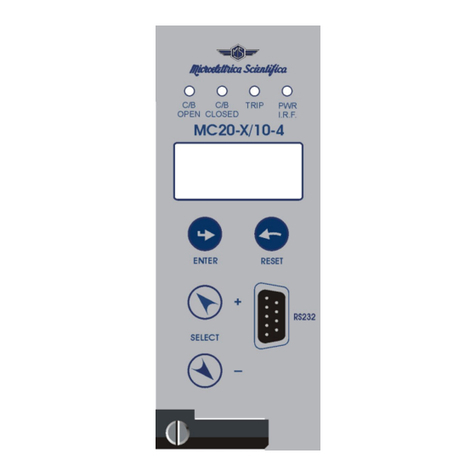
MICROENER
MICROENER MC20-X/10-4 User manual
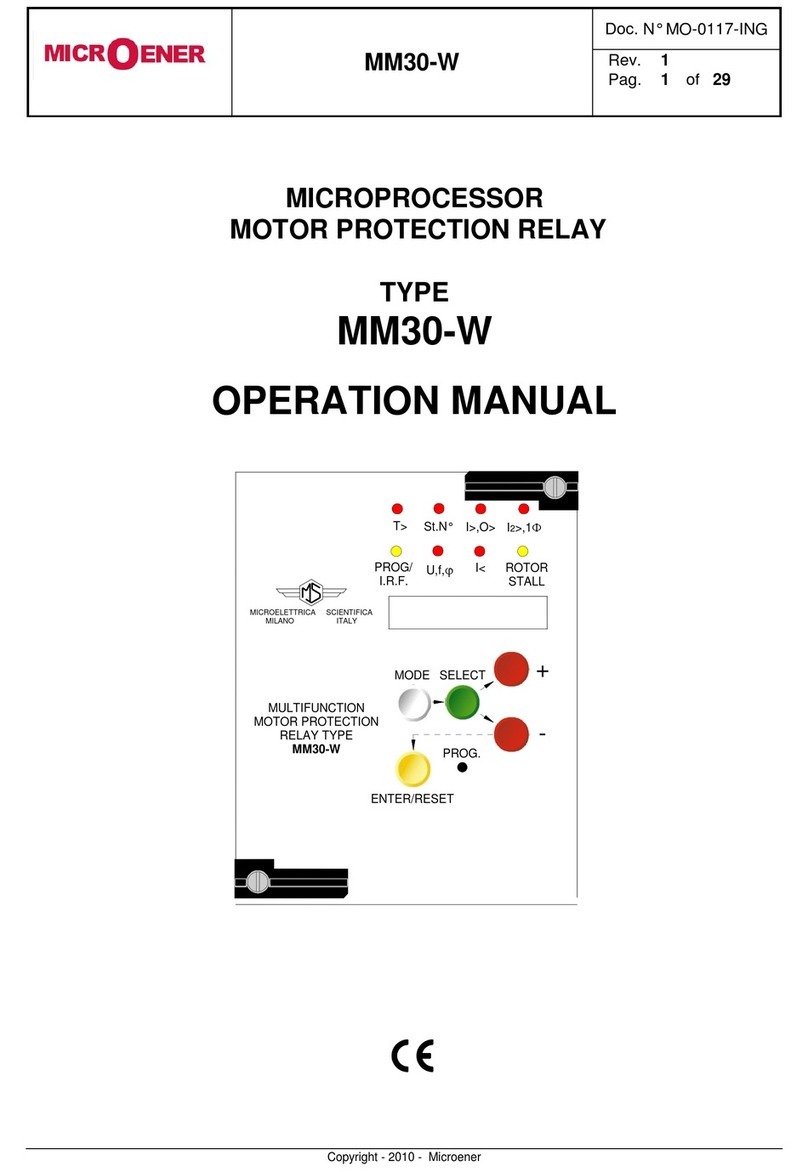
MICROENER
MICROENER MM30-W User manual
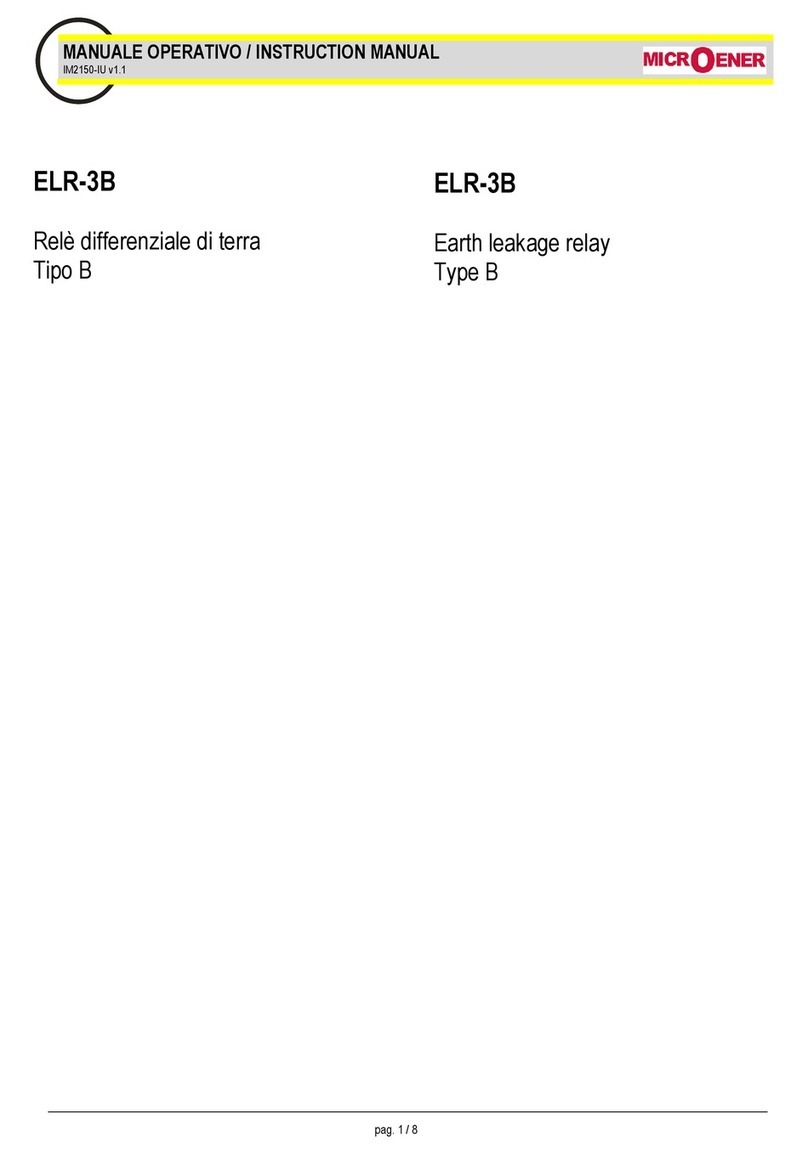
MICROENER
MICROENER ELR-3B User manual
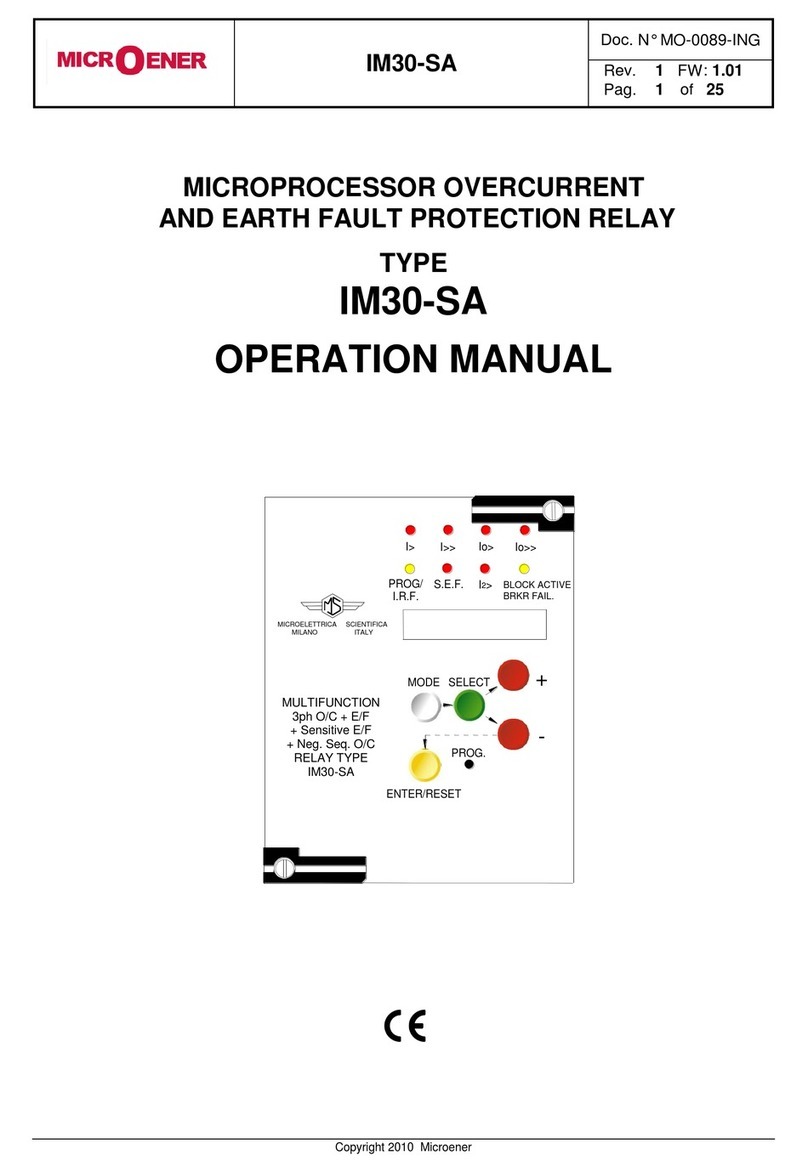
MICROENER
MICROENER IM30-SA User manual

MICROENER
MICROENER ULTRA Series User manual
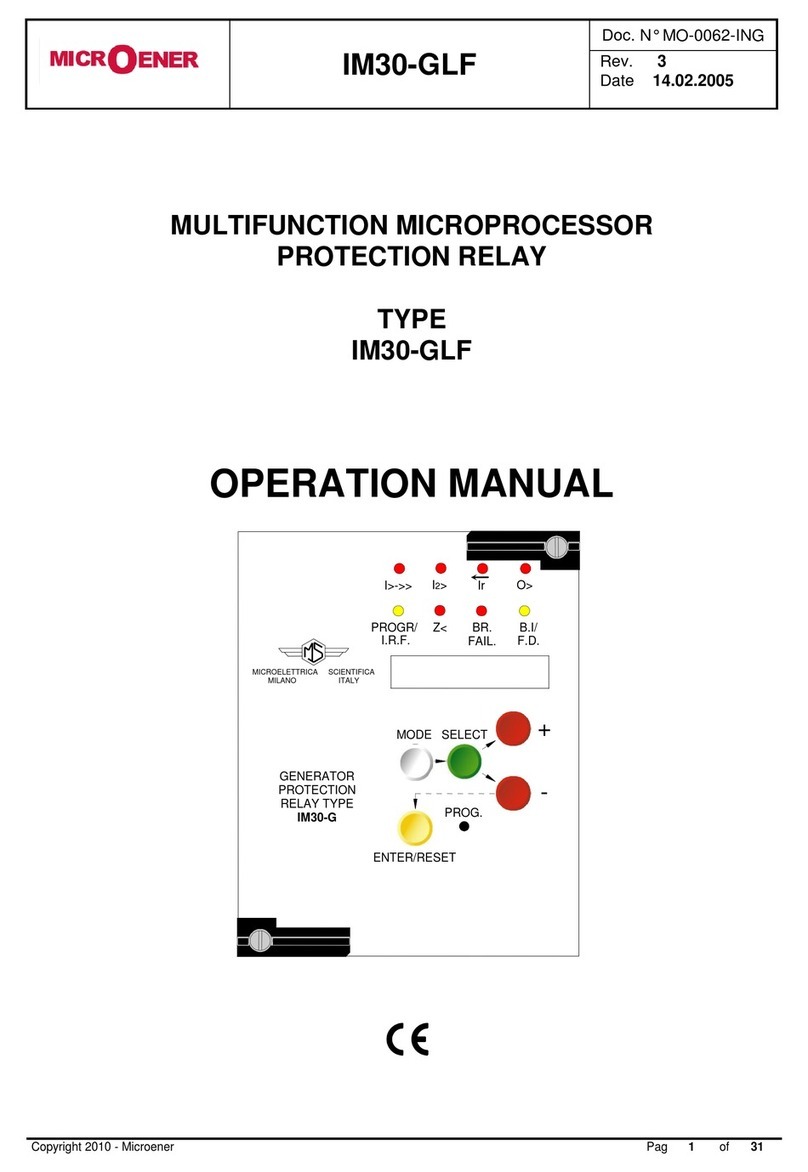
MICROENER
MICROENER IM30-GLF User manual
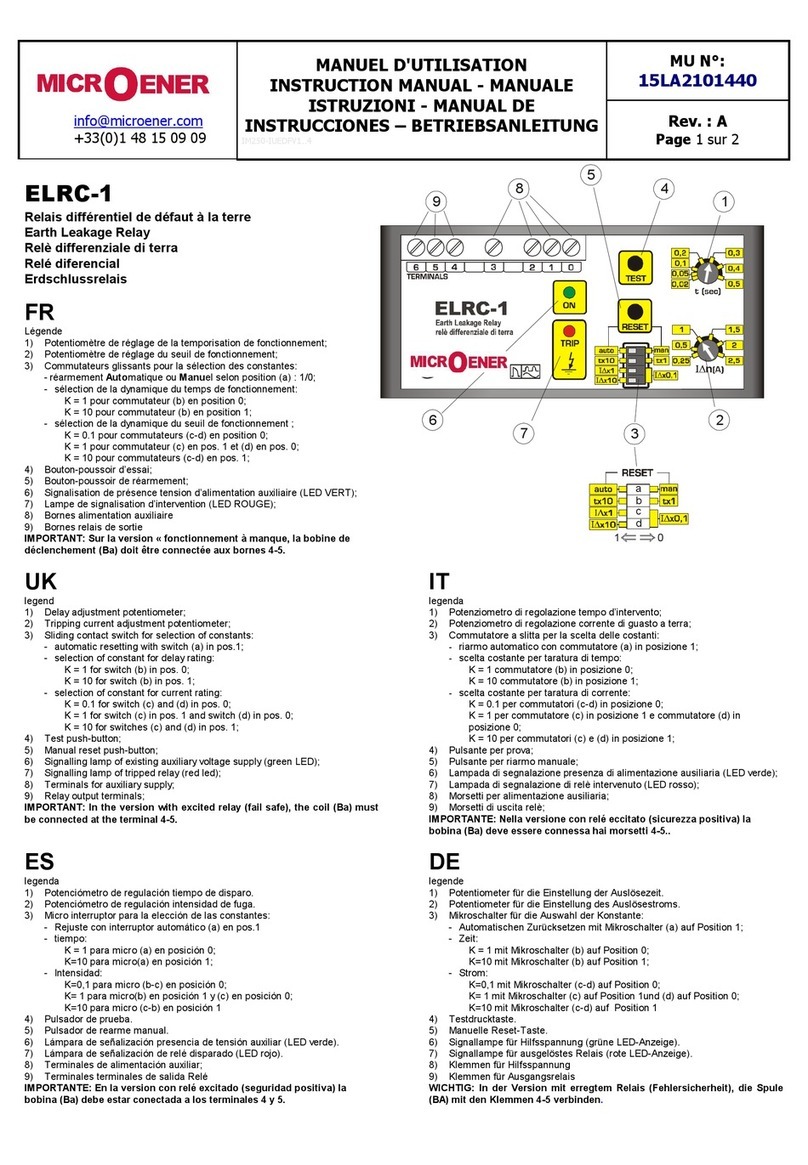
MICROENER
MICROENER ELRC-1 User manual

MICROENER
MICROENER IM30-DK User manual

MICROENER
MICROENER IM3G-VX User manual
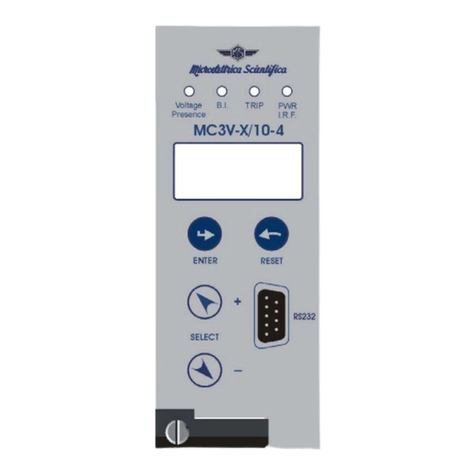
MICROENER
MICROENER MC3V-X/10-4 User manual
Popular Relay manuals by other brands
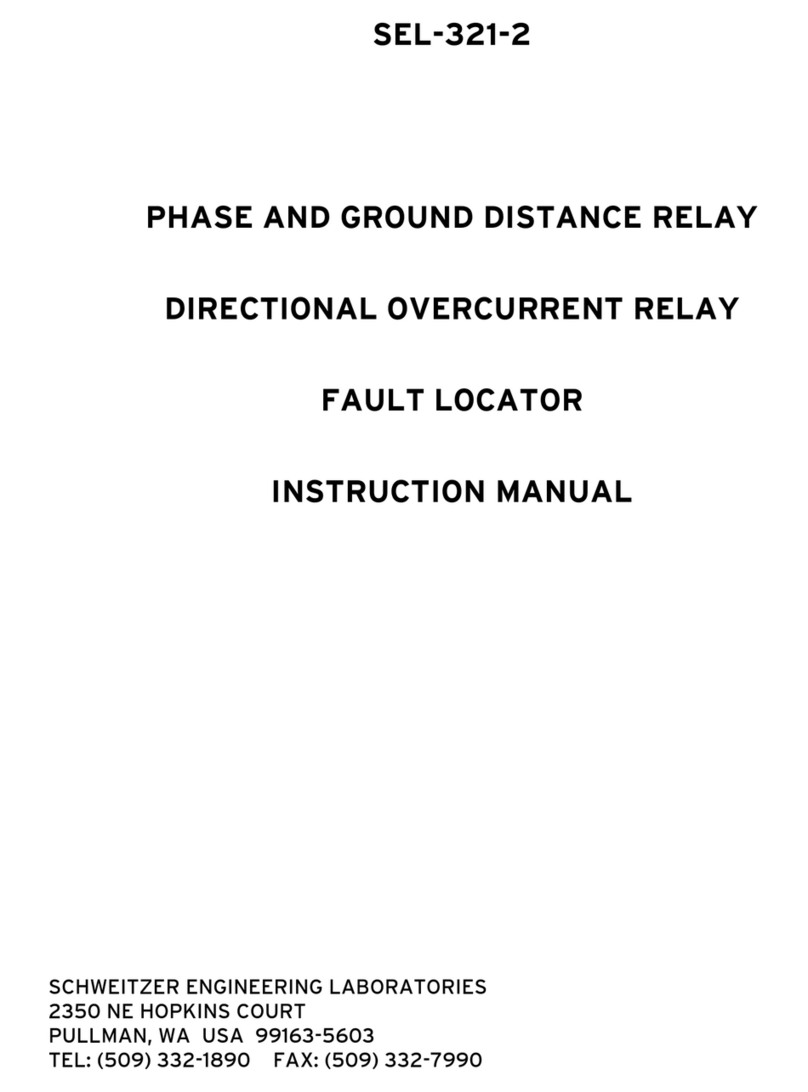
Schweitzer Engineering Laboratories
Schweitzer Engineering Laboratories SEL-321-2 instruction manual
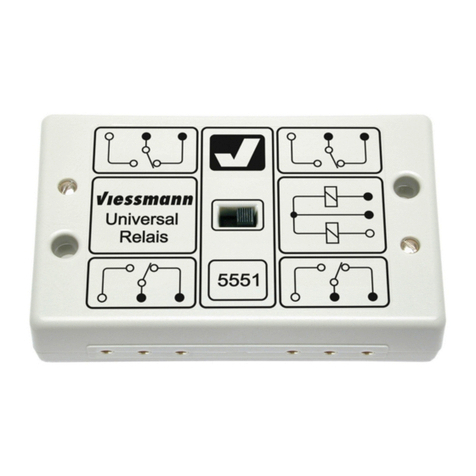
Viessmann
Viessmann 5551 operating instructions
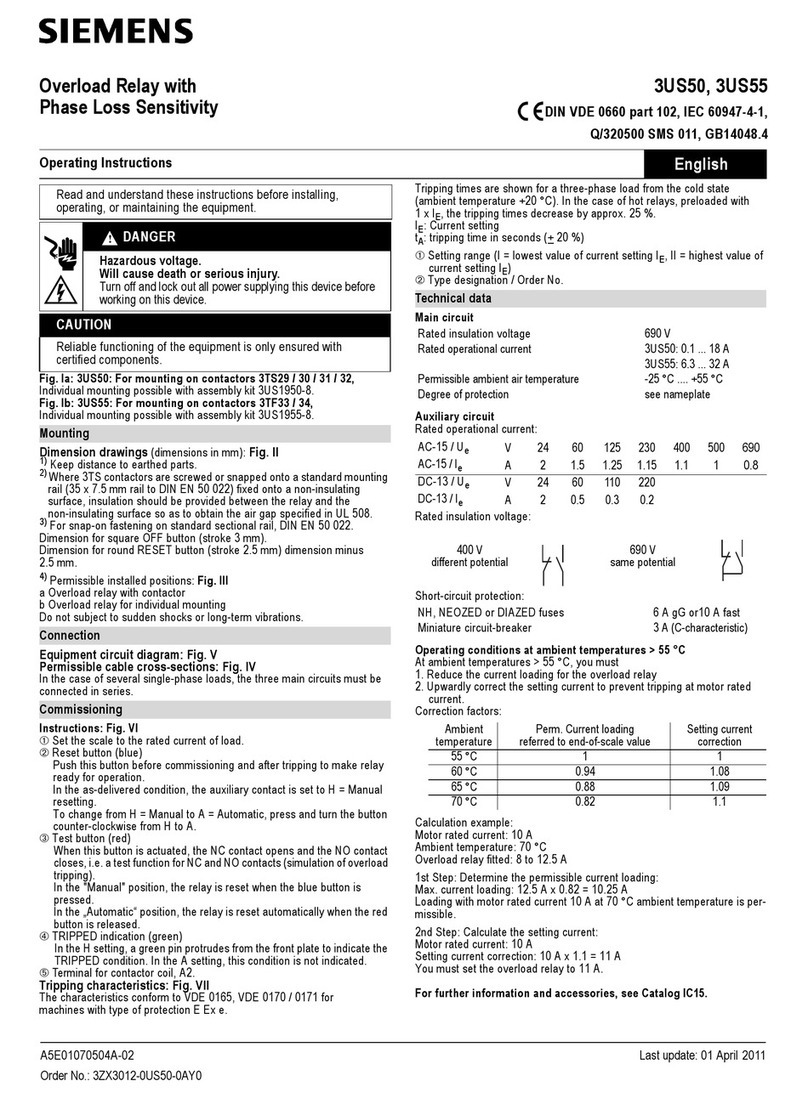
Siemens
Siemens 3US50 operating instructions
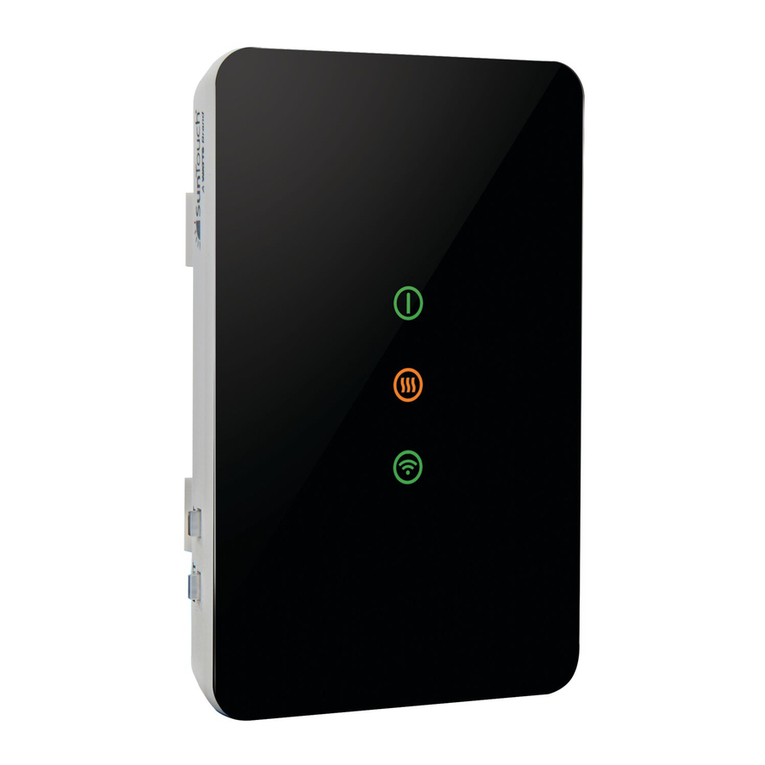
Watts
Watts SunTouch SunStat R4 Relay user manual

Pilz
Pilz PNOZ s30 operating manual
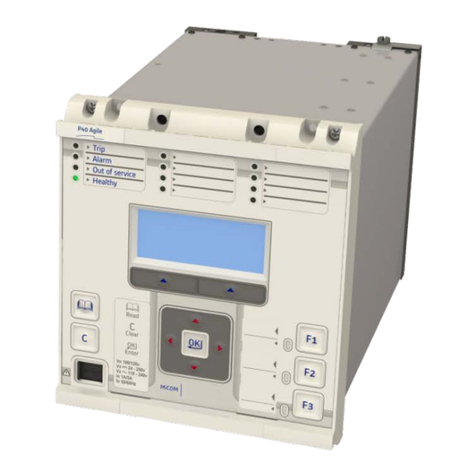
GE
GE MiCOM P40 Agile P14D manual
